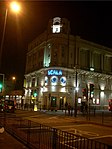Balderton Capital

Balderton Capital is a venture capital firm based in London, UK, that invests in early-stage, technology and internet startup companies in Europe. It is considered to be among the four-biggest venture capital firms in the English capital.Founded in 2000 as Benchmark Capital Europe, Balderton Capital became fully independent in 2007. The company made over 100 early-stage investments between 2000 and 2020, including Revolut, Betfair, The Hut Group, MySQL, Yoox, Depop, Talend, Recorded Future, NaturalMotion, Kobalt Music Group, GoCardless, CityMapper, and Sophia Genetics In November 2019, Balderton announced Balderton VII, a new $400m fund to invest in European companies at Series A. The new fund will reportedly make approximately 12 investments annually. In 2018, Balderton announced the first fund dedicated to buying equity from existing shareholders of European technology startups. In 2021, Balderton announced the first fund dedicated to growth, with $680M under management and a further $600M for early stage investing, bringing its total assets to over $5B.
Excerpt from the Wikipedia article Balderton Capital (License: CC BY-SA 3.0, Authors, Images).Balderton Capital
Britannia Street, London King's Cross (London Borough of Camden)
Geographical coordinates (GPS) Address Phone number Website Nearby Places Show on map
Geographical coordinates (GPS)
| Latitude | Longitude |
|---|---|
| N 51.529792 ° | E -0.118778 ° |
Address
Gagosian
Britannia Street 6-24
WC1X 9JD London, King's Cross (London Borough of Camden)
England, United Kingdom
Open on Google Maps











